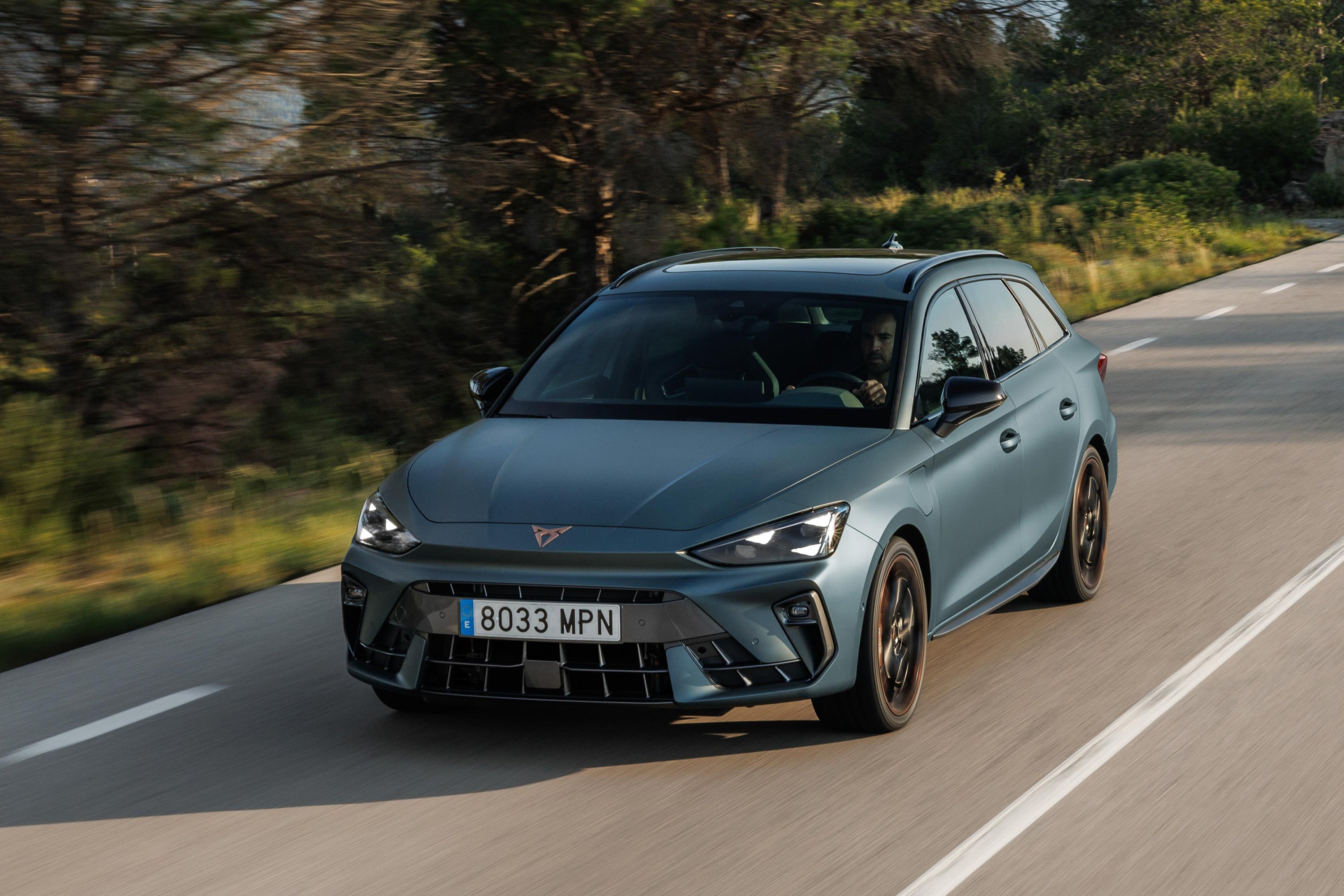Cupra Leon Estate Review 2025: Price, specs & boot space
Written by Ivan Aistrop
Quick overview
Pros
- Big boot
- Range-topper is properly quick
- Fun and easy to drive fast
Cons
- Entry-level versions are a little underwhelming
- Pre-facelift cars look a little bland
- Early examples aren’t as well kitted as later ones
Overall verdict on the Cupra Leon Estate
"The Cupra Leon Estate is a compact wagon that can play a wide variety of roles very effectively indeed. Find out why in our 2025 Cupra Leon Estate review."
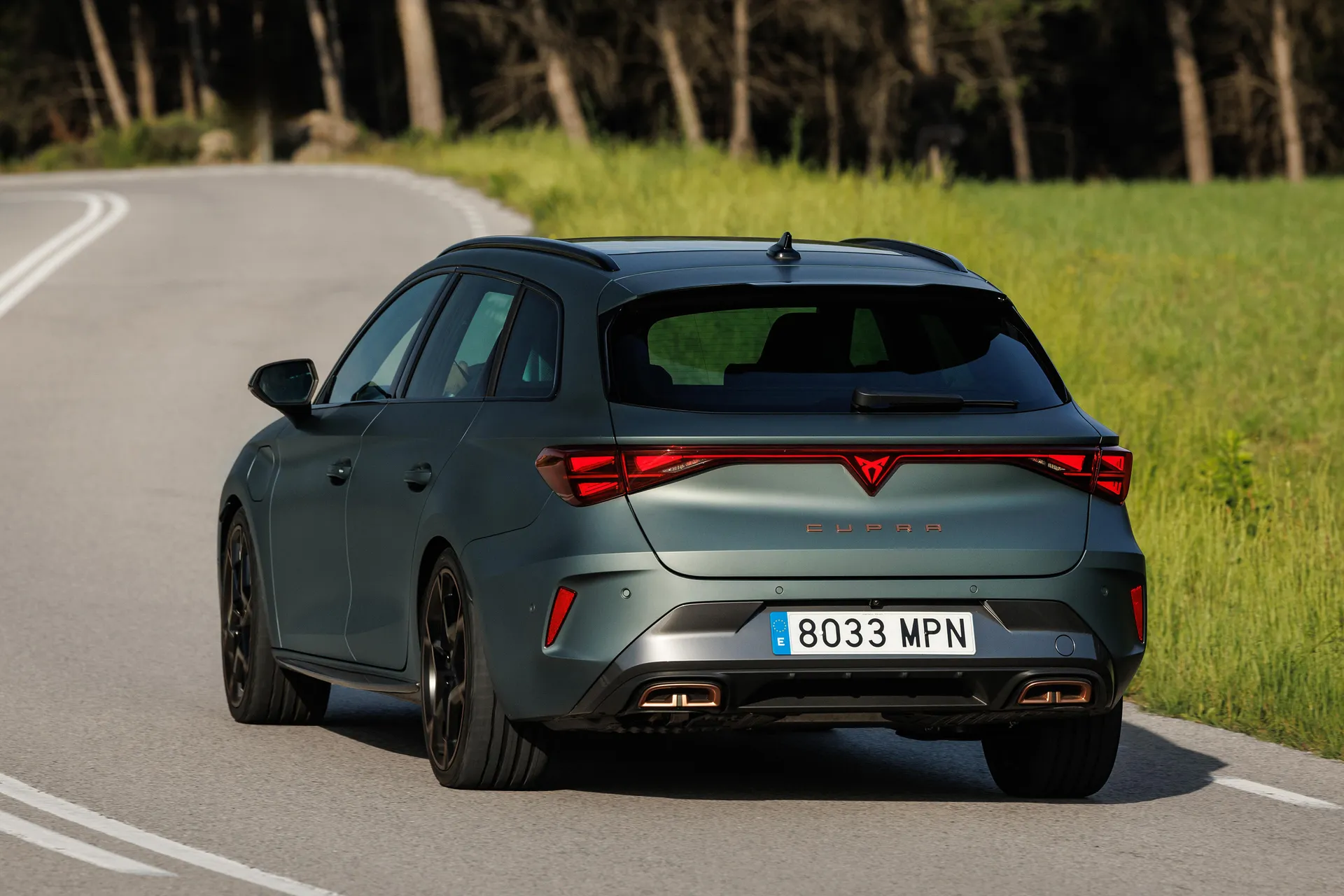
There was a time, not all that long ago, when the new car market offered a wide variety of hot hatch contenders for those who needed everyday practicality, but wanted a slice of fun to go with it. Nowadays, however, the number of such cars on the market has dwindled considerably, with only a handful left. And if you are in the rather more niche position of wanting a cargo-carrying estate version of such a car, then your options are even more limited.
The Cupra Leon Estate is just such a car, or rather, it was. Yes the range-topping versions still offer massive power of more than 300 metric horsepower, and deliver crackerjack performance as a result, but while the car was once high-performance-only, Cupra now offers much more modest versions with lower power outputs, more affordable purchase prices and lower running costs, but still with the racy styling and attitude of the pokier cars.
And on the subject of styling and attitude, we should mention the facelift that the car was given in late 2024. Where previously the Leon had looked a little bland, particularly in hot-hatch circles, the restyle brought by the facelift injected a fair dose of visual steroids, with more aggressive body creases, bigger air intakes and a cool triangular design motif in the headlights. To our eye, the facelifted cars look way, way better, and they also come with significantly enhanced kit levels and upgraded powertrains as well.
Importantly for an estate car, practicality levels are good, with a large 620-litre boot (provided you avoid the plug-in hybrids) and plentiful passenger space. Cabin quality is something of a mixed bag, but all the technology you expect is present and correct.
The generous power levels are accompanied by agile and involving handling, yet there’s enough comfort and refinement to keep life easy and relaxing on the daily grind.
All in all, the Cupra Leon Estate is a jack of all trades, that genuinely does feel like a master of some. And it’s a very likeable car as a result.
Is the Cupra Leon Estate right for you?
If you’re looking for a compact estate car that has a sporty edge, but is easy and comfortable to live with day-to-day, all while delivering impressive practicality, then the Cupra Leon Estate is a really good choice.
What’s the best Cupra Leon Estate model/engine to choose?
That depends on what you want. The lower-end V models deliver the same style and attitude as racier versions, but are more affordable to buy and insure, while the PHEV versions have the potential to be exceptionally cheap to run. For a proper hot-hatch experience, though, you’ll want the top-of-the-range 2.0-litre turbo version with its 333PS.
What other cars are similar to the Cupra Leon Estate ?
If you’re looking for a sporty compact estate car, then there really aren't very many left these days, and those there are come mainly from elsewhere in the sprawling Volkswagen group. The VW Golf R Estate is essentially the same car underneath, and while the Skoda Octavia vRS Estate uses the same platform, it doesn’t boast as much power. There’s a sporty version of the Vauxhall Astra Sports Tourer in the form of the GTE, but this plug-in-hybrid model is down on power as well.
Comfort and design: Cupra Leon Estate interior
"You shouldn’t have too much trouble getting comfortable at the wheel of the Cupra Leon. The entry-level V1 car has sports seats with manual adjustment, but all of the others have supportive bucket seats to hold you in place as you whizz around corners, and these bucket seats have electric adjustment."
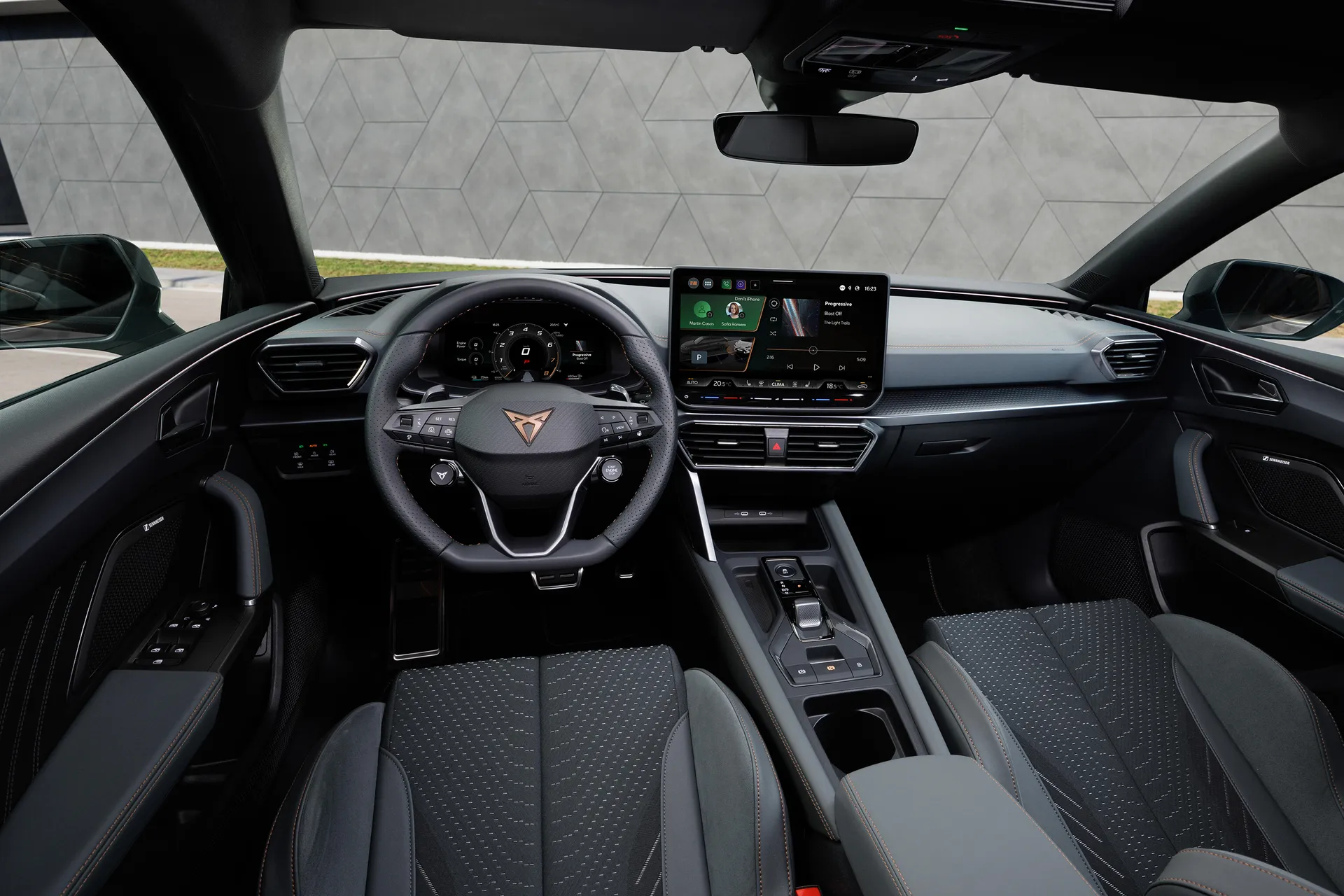
Large windows all round mean you get a good view out in all directions, which certainly isn’t the case in some hot hatches.
The dashboard design is simple, with only a few large buttons on the centre console, and these are clearly marked. There’s a collection of smaller buttons on the steering wheel, and these also have clear markings, so it’s fairly obvious what all these do as well.
Most of the car’s functions, however, are operated by the touchscreen, which we’ll come onto in a minute. What we will talk about now, though, are the touch-sensitive slider controls for the stereo volume and temperature, which are much fiddlier and less accurate than a conventional dial would be. In pre-facelift cars, they’re not illuminated, either, so finding them - let alone using them - in the dark is nigh-on impossible. This oversight was fixed during the 2024 facelift.
Quality and finish
The Cupra Leon is a bit of a mixed bag in this area. In some places, it’s really impressive, with dense, squidgy materials used on top of the dashboard and door trims, giving a mainly posh-feeling environment. In other places, however, the materials are much more dowdy: the plastics used in the centre console are a case in point.
It’s not enough to ruin the car’s overall plushness, but it does detract from it a bit. You’ll also notice that the colour schemes are very dark and sombre, with only a few trademark copper-coloured highlights. Some will like the understated feel, while some others will crave a bit more hot-hatch-style chintz.
Infotainment: Touchscreen, USB, nav and stereo in the Cupra Leon Estate
Early Cupra Leons had a 10.0-inch infotainment screen in the centre of the dashboard, but as part of the facelift in 2024, this was upgraded to a 12.9-inch unit. The functionality provided as standard includes sat-nav, Bluetooth, DAB radio, Apple CarPlay and Android Auto (wireless after the facelift).
The screen is standard Volkswagen-Group fare, which means that while it’s bright and responsive, it can be fiddly and confusing to use, which distracts you from the road ahead.
The standard stereo system has seven speakers, but the VZ3 trim comes with a 10-speaker Sennheiser stereo upgrade as standard, while it’s available as an option on most other versions.
All Cupra Leons come with digital dials and four USB charging points, two in the front and two in the back. In pre-facelift cars, wireless phone charging was only standard on top-spec VZ3 cars, but during the facelift, this feature was made standard across the range.
Space and practicality: Cupra Leon Estate boot space
The fact that you’re reading a review of the Cupra Leon Estate, rather than the hatchback, would suggest that you have at least a passing interest in boot space, so let’s start there. If you go for the plug-in hybrid version, you might be a fraction disappointed, because you only get 470 litres of space, which isn’t great.
Go for one of the more regular combustion-engined versions, though, and your reaction is likely to be the exact opposite, because you get an absolutely whopping load area of 620 litres to play with, and that’s a lot. What’s more, the space is usefully square-sided and access is brilliant. If you have a lot of flatpack furniture that you need to transport as quickly as you can, or you have a dog that you want to make violently sick, then this is the car for you.
For the maximum amount of space to be available, you have to have the adjustable boot floor set in its lower position, and in that format, there's a significant step at the entrance of the boot. That can be levelled off by raising the floor to its higher position, at the cost of a bit of space (although you can still stash items in the large space underneath). The rear seats fold down in a 60/40 split, and raising the boot floor also levels off the step up to the folded backrest, making your extended load floor level. Those backrests do lie at a slight angle, though, so there is a gentle slope to contend with.
Space in the passenger compartment is fine, with generous room up front and enough legroom and headroom in the back for tall adults to sit comfortably, although some rivals do give a bit more room to stretch out.
Handling and ride quality: What is the Cupra Leon Estate like to drive?
"We haven’t yet driven the entry-level V1 version of the Cupra Leon Estate, which has a passive suspension. However, the rest of the range gets Cupra’s Dynamic Chassis Control adaptive suspension system as standard, and it’s very, very effective."
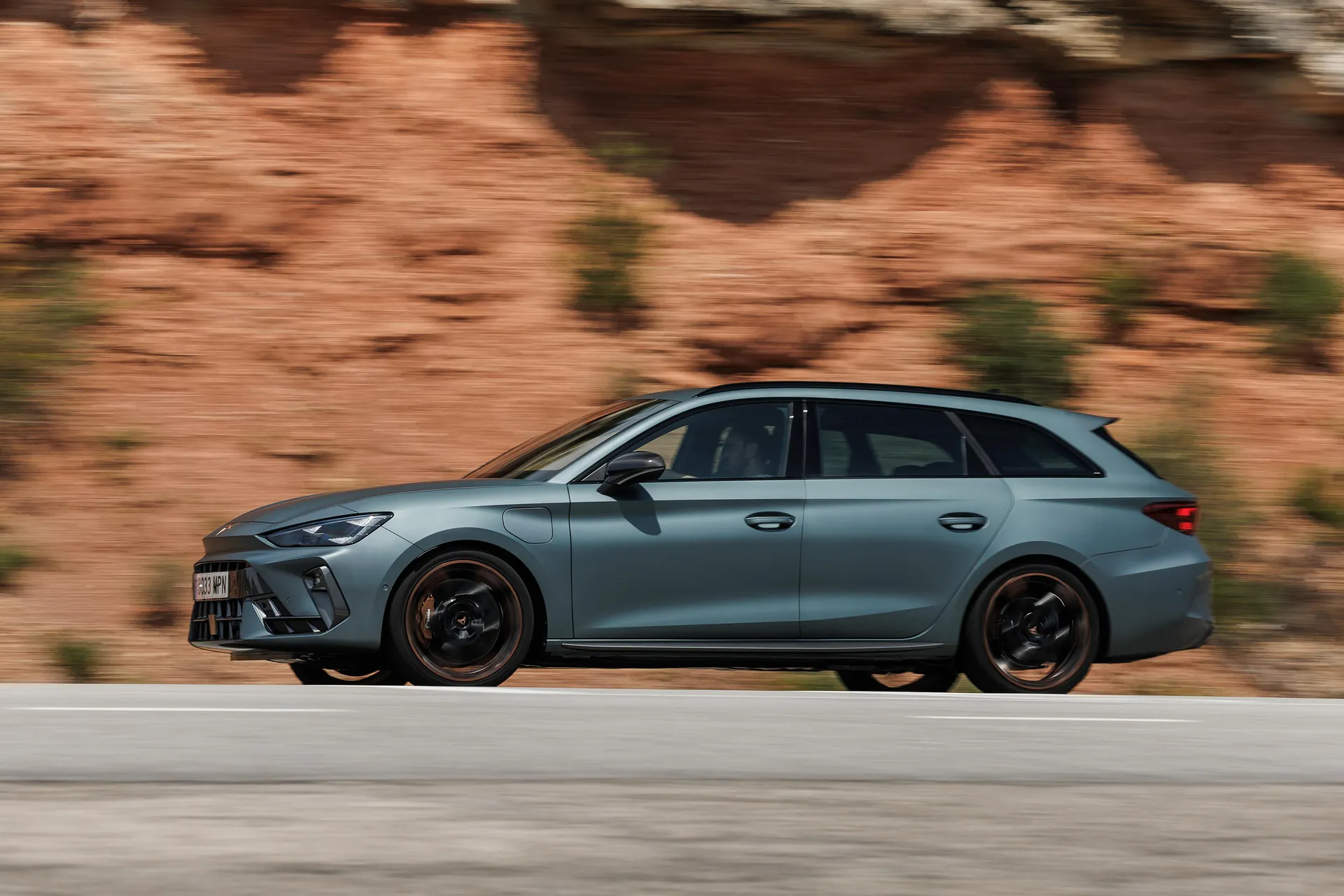
It changes the softness or stiffness of the suspension according to which of the various drive modes you select, or in the Individual mode, you can select from a multi-stage scale of different stiffness options.
In the more comfortable settings, the ride is settled and comfortable: there’s a slight edge, as you’d expect in a sporty car like this, but there’s easily enough compliance to take the sting out of all but the worst of bumps.
Scroll through to the sportier modes, and you progressively feel more sensation from the surface beneath you, but even then it doesn’t get uncomfortable, dispensing with bumps in a firm-but-fair way. Body control also becomes progressively tighter, aiding your agility in corners and making direction changes feel keener. Grip and traction is mighty thanks to the four-wheel drive system, and the steering has a nice meaty weight and a responsive feel.
What’s really nice about the way the Cupra handles, though, is that it’s actually very adjustable mid-corner. A small lift of the throttle allows you to instantly adjust your heading, but any movement of the back end is incredibly easy to control, and that shows some real engineering polish. You’ll also like the fact that this is a very easy car to drive quickly, making its prodigious pace very accessible. Some hot-hatch die-hards may bemoan the fact that it doesn’t have the visceral lunacy of something like a Honda Civic Type R, but if you just want to get in a go like the clappers – and take a sideboard with you – then it’s hard to beat.
What engines and gearboxes are available in the Cupra Leon Estate?
The lineup of engines available in the Leon Estate is slightly different to that of the hatchback version. Early on, you could only have it with one of two powertrains.
The first was a plug-in hybrid that combined a 1.4-litre petrol engine with an electric motor and a 12.8kWh battery, giving 245PS, a 0-62mph time of 7.0 seconds, and an electric-only range of up to 34 miles.
It’s a brisk performer, happily scurrying up to motorway speeds under electric-only propulsion with a seamless, unbroken progression of forward motion. If you’re expecting hot-hatch pace from this version, though, you might be disappointed because it simply doesn’t deliver it. The powertrain can sometimes get caught napping when you ask for full acceleration, too, because there’s a pause before the motor and engine figure out between them how to best respond.
The other engine was the range-topping 2.0-litre turbocharged petrol engine. While rated at 300PS in the Cupra Leon hatchback, this powerplant was uprated to 310PS for the Estate, and fitted with four-wheel drive. And this truly does deliver proper hot hatch pace, with a 0-62mph figure of just 4.9 seconds. It feels good for every millisecond of that, too, with searing acceleration away from the mark, and mighty in-gear muscle. Select the car’s Cupra mode, and your barnstorming pace will be accompanied by a bare-chested bellow from the exhaust, while the shifts from the seven-speed automatic gearbox punch through with more speed and ferocity. Full throttle in this thing is quite an experience.
Later on, the engine range was broadened to offer more modest and affordable choices. We haven’t yet tried the car with its entry-level 150PS 1.5-litre petrol engine – offered with or without 48-volt mild hybrid assistance – but we’ve experienced this powertrain in enough alternative VW-Group products to hypothesise that while this engine will do an entirely adequate job in terms of pace and flexibility, it certainly won’t have the hot-hatch performance that its bold looks suggest. A 0-62mph time of around nine seconds would support this theory.
Then there are a pair of plug-in hybrids that pair the 1.5-litre petrol engine with an electric motor and a bigger (than before) battery of 25.8kWh, giving either 204PS or 272PS. We haven't tried either yet, and we haven't even seen figures for the less powerful version, but the more powerful iteration delivers a 0-62mph time of 7.2 seconds and an electric-only range of up to 77 miles.
The crackerjack of a 2.0-litre turbocharged petrol engine still sits at the top of the range, but it’s since been upgraded to 333PS. The 0-62mph dash comes and goes in an even quicker 4.8 seconds, and while you won’t really detect the extra pace it has compared to before, it’s still eye-wideningly quick and certainly no less dramatic
Refinement and noise levels
Even with the most powerful version of the Cupra, you might be surprised by how civilised it is day-to-day when you’re just bimbling about. Sure, the wide tyres do kick up a bit of road noise, but it’s not too overbearing, and wind noise is well isolated. The engine stays quiet, smooth and distant when you treat it gently, although if you switch over to Cupra mode and get medieval on the throttle pedal, it changes character completely, with a snarling bellow to accompany your acceleration.
Predictably, the plug-in model we’ve tried (the early one with the 1.4 engine) is exceptionally quiet when running in electric-only mode, and with the petrol engine running, it only becomes vocal if you really thrash it: it’s fine most of the time. We haven’t tried the later PHEV offerings with the 1.5 engine, though, so we don't know if these are any better on that score.
Safety equipment: How safe is the Cupra Leon Estate?
The Cupra Leon was crash tested by Euro NCAP in 2020 and was awarded the full five-star rating, but the tests get more difficult to ace year-on-year, so there’s no telling what it would earn if tested again today.
The amount of safety kit your Leon has will depend on when it was built. Early on, the standard kit included six airbags, automatic emergency braking, lane assist, and tiredness recognition. Further driving aids could be added courtesy of three option packs providing various levels of assistance. The most comprehensive one came as standard on the 300PS version, and provided dynamic road sign display, high-beam assist, adaptive cruise control, blind spot monitoring, and lane change assist.
The safety roster was enhanced later on during the 2024 facelift. All versions now get high beam assist, dynamic road sign display and adaptive cruise control, while VZ3 trim gets an additional driver’s knee airbag, plus lane change assist and blind spot monitoring.
MPG and fuel costs: What does a Cupra Leon Estate cost to run?
“Early on, you could only have the estate version of the Cupra Leon with the plug-in hybrid powertrain of the most powerful version of the 2.0-litre turbo (the one in the estate had 310PS while the one in the hatchback equivalent was limited to 300PS). The former had an official fuel economy figure of 201.8mpg, while the latter returned 34.4mpg. And no, that’s not a typo.”
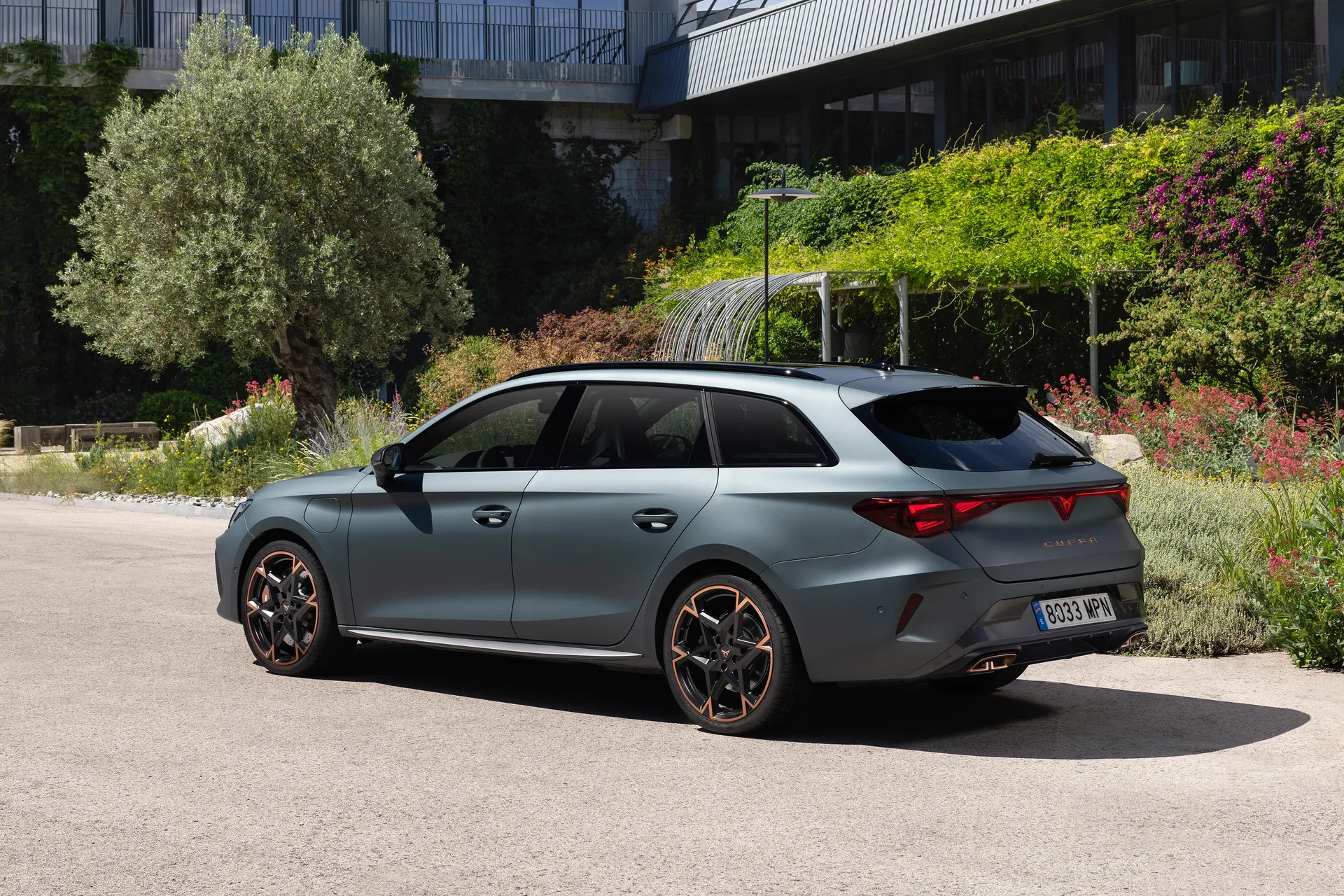
Don’t be fooled, though, because the PHEV’s super-high figure is a symptom of the official tests being unrealistically flattering to plug-in hybrids, and you’ll likely not get anywhere near that in the real world. If you charge up regularly and confine yourself exclusively to short hops that can be completed on electric-only power, then you’ll never use any petrol. As soon as you run the battery down, though, the car will become very thirsty indeed because the petrol engine has to lug about the extra weight of the battery. Expect economy similar to that of the 2.0-litre petrol, which is a much more realistic figure, although your returns will plummet if you use the car’s performance like its makers intended.
Later on, the Leon Estate was made available with more modest engine offerings. The regular 150PS 1.5 petrol returned around 47mpg, or 50mpg when equipped with Cupra’s eTSI mild hybrid technology.
We haven’t seen a figure for the 204PS version of the PHEV, but the 272PS version posts an official figure of up to 706mpg, which is even less plausible than before, and for the same reasons. The most powerful version of the 2.0-litre – now with 333PS – returns up to 34mpg according to official figures. All the same caveats as before apply with these engines.
Cupra Leon reliability and warranty
Take a look at the latest instalment of the HonestJohn.co.uk Satisfaction Index – put together by our excellent sister website – and you’ll likely feel pretty good about the potential reliability of your Cupra Leon. The brand placed a very creditable 13th out of 33 carmakers ranked in the reliability standings, so that’s well ahead of the industry average.
Perhaps even better is that Cupra is the only Volkswagen Group brand that doesn’t come with a bog-standard three-year warranty. Instead, you get five years and 90,000-mile coverage.
Insurance groups and costs
Early on in the life of the Cupra Leon Estate, it could only be had with the 245PS plug-in hybrid powertrain and the punchy 310PS 2.0-litre turbo. Both are very powerful, then, and so have relatively high insurance groupings as a result: it’s 31 on the former and 33 or 34 on the latter, depending on trim level.
Later on, it was made available with more modest engine and trim choices, and so insurance classifications fell accordingly. They start at group 20 for the 150PS 1.5-litre petrol version in V1 trim, and rise to group 34 for the range-topping 2.0-litre turbo petrol, which now has 333PS.
VED car tax: What is the annual road tax on a Cupra Leon Estate?
Since April 2025, the type of fuel your car uses makes no difference to the amount you pay for car tax. You now pay a flat rate of tax on all fuel types, and that flat rate currently stands at £195.
The amount you pay will, however, be affected by how much your car cost when it was brand new. That’s because cars that cost more than £40,000 (including optional extras) are liable for the government’s luxury car surcharge on VED tax, which basically adds another £425 per year to your annual tax bill for a temporary five-year period between years two and six of the car’s life. And you can’t get around it by buying used because that liability is passed onto the car’s subsequent owner. The question is, does this affect the Leon Estate?
Well, it could. It’s fair to say that the world has changed a lot since the car first went on sale in 2021, and the cost of everything has gone up significantly. Once upon a time, it was only the most expensive range-topping version of the car that busted the threshold. These days, however, pretty much half the range does: anything with a VZ prefix rather than a V. If buying used, then we’d always recommend Googling the reg of any potential purchase to figure out if buying it will lumber you with the increased tax rate.
Cupra Leon Estate price
"If you were to stroll into your Cupra dealership today and factory-order a brand new one, then you’d find that prices start at around £33,000 for the most basic V1 car with the entry-level 150PS petrol engine, or a couple of grand more if you specify the mild hybrid tech."
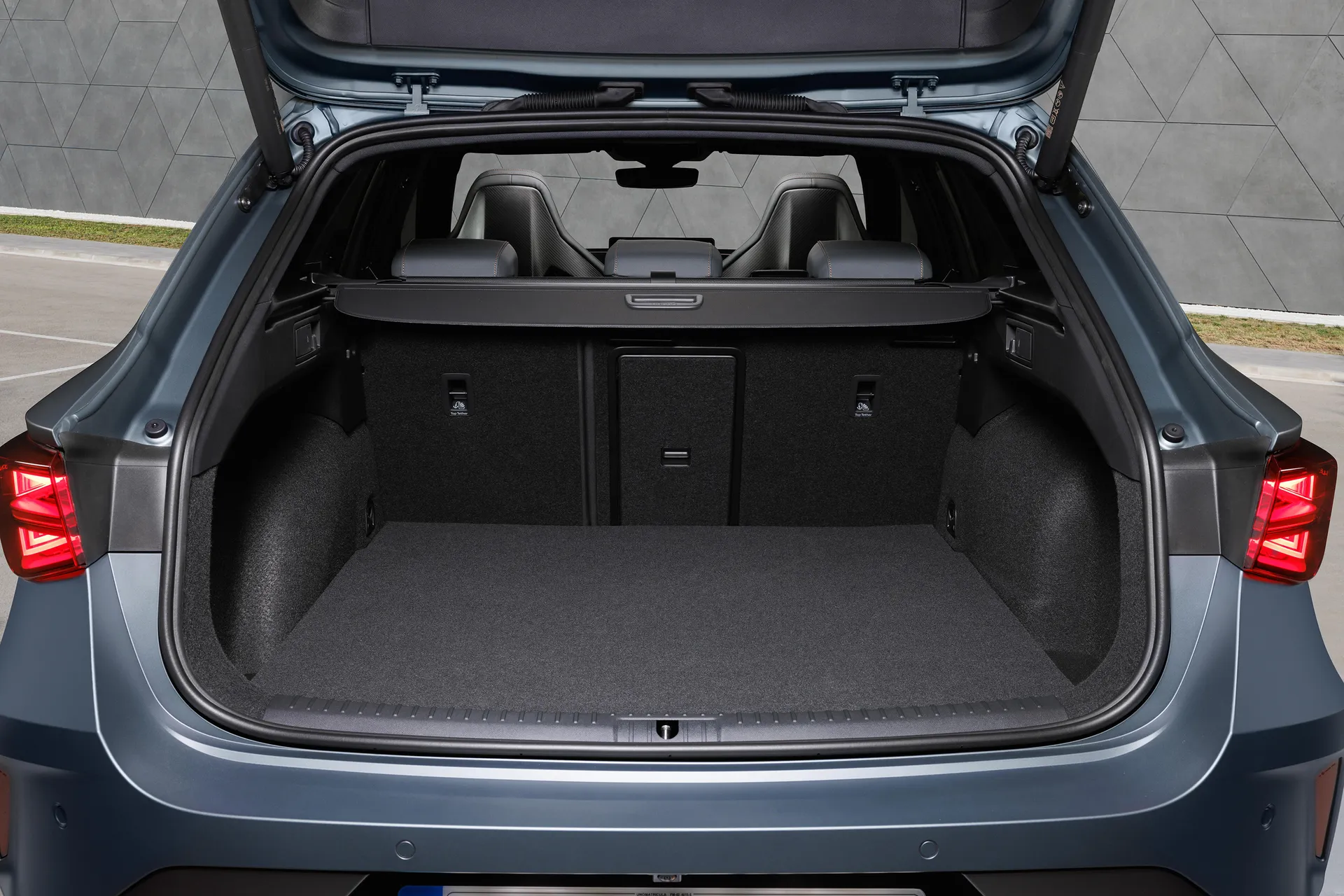
Specifying V2 trim will cost about another £2,500, while V3 trim will cost another £1,500 on top.
The more powerful VZ cars start at around £44,000 with the VZ1 fitted with the 272PS plug-in hybrid powertrain. You’ll pay less than a grand on top for the range-topping 2.0-litre engine. Again, the step up to VZ2 trim costs about £2,500, but the step up to VZ3 trim is steeper at more than £3,000.
As ever, however, you can save a vast amount of money by searching out a used example instead. Around £22,000 will get you an entry-level 1.5 TSI V1 from 2024, although this will be from just before the facelift, so will have the blander looks, but it’ll still only have around 10,000 miles on the clock.
Around £28,000 will be needed to get you into a 2023 example of the high-performance 2.0-litre or a similarly specced 272PS plug-in hybrid from 2024 (pre-facelift). Around the same amount will be needed for a low-spec version of the smarter-looking facelifted car. You pays your money and makes your choice, as they say…
Trim levels and standard equipment
Early on, the Cupra Leon was available in three trim levels: VZ1, VZ2 and VZ3. Entry-level VZ1 models get 18-inch wheels, LED exterior lights with dynamic indicators and a slightly more aggressive body kit than a regular SEAT Leon. On the inside, you get a 10.0-inch centre infotainment screen and digital dashboard, ambient lighting, sports seats, sports steering wheel, metal pedals, front- and rear parking sensors, and a reversing camera.
Larger 19-inch wheels are the extent of the Cupra Leon VZ2 models' exterior upgrades, while mechanical changes include the excellent adjustable dampers.
Cupra Leon VZ3 models also have 19-inch alloy wheels but with serrated plastic trims that, we're ashamed to say, we quite like. Inside, you get leather seats that are heated and electrically adjustable, plus a hands-free powered tailgate and wireless phone charging.
Post-2024 facelift cars offer more choice and more kit throughout the range. There are the sensible and more affordable V1, V2 and V3 models, which are offered exclusively with the more modest powertrains. Then there are the more performance-focused VZ1, VZ2 and VZ3 trims, which come exclusively with the more potent powertrain options.
Cupra Leon V1s get 18-inch wheels, LED headlights and taillights, rain-sensing wipers, front- and rear parking sensors and the full infotainment package with a 12.9-inch screen and a wireless phone charger. The V2 trim adds 19-inch wheels, adaptive suspension, and the electric boot lid. Inside, there are heated front seats and electric adjustment for the driver, as well as a rear-view camera and keyless engine and start. The V3 gives you black and copper 19-inch wheels, leather upholstery and electric adjustment for both front seats.
In addition to what you get in the V1, the VZ1 adds 19-inch wheels, adaptive suspension, heated front seats and matrix LED headlights, as well as Dinamica (synthetic suede) upholstery and a rear-view camera. VZ2 adds leather upholstery, powered front seats, and different 19-inch wheels, while VZ3 has upgraded brakes, black and copper wheels, a beefier bodykit with a roof spoiler and side skirts, bucket seats and an upgraded Sennheiser sound system.
Ask the heycar experts: common questions
Is the Cupra Leon Estate fast?
Is the Cupra Leon Estate a good estate car?
How much does the Cupra Leon estate cost?
Get our latest advice, news and offers
Keep me updated by email with the latest advice, news and offers from heycar.
By submitting you agree to our privacy policy
